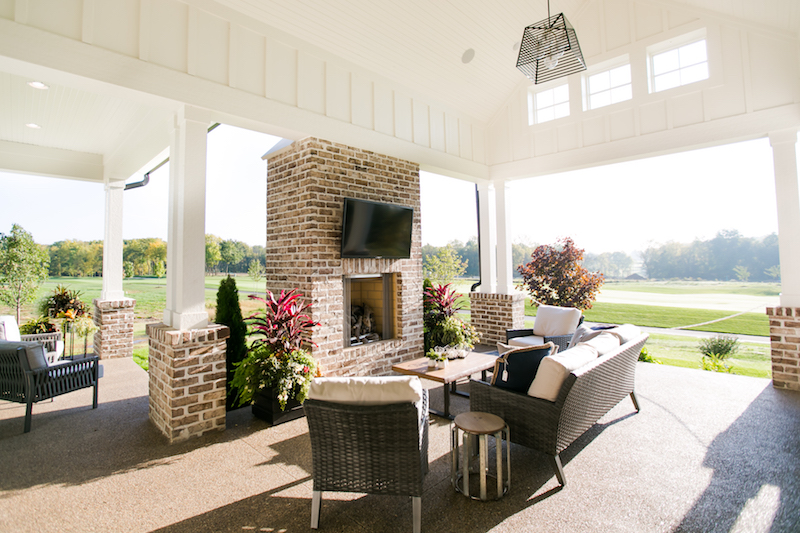Integrators, Designers, and Architects have the Tech They Need to Enhance Clients’ Enjoyment of Al Fresco Spaces
Quick, before it gets too cold, add a room onto that house without hanging any drywall. These days, one of the most in-demand living spaces is the great outdoors.
When the coronavirus pandemic began, people were forced to spend more time at home – and they found they wanted to do a little home improvement. According to a survey of 1,000 consumers by Houzz, a home renovation and resource web site, 79 percent said they were considering major home remodeling and design projects after sheltering in place for a while. Nearly one in four of those homeowners said they planned to upgrade or add an outdoor space for enjoyment or work-from-home productivity.
The space outside a home’s four walls is the new rec room and should be considered as such by residential systems integrators, interiors designers, remodelers, and even landscape architects. The evidence suggests homeowners are thinking of ways to spend more time outdoors, building fire pits, bars, kitchens, and even outdoor cinemas. When contractors offer an estimate for work inside a house, they’re missing an opportunity if they don’t also propose a vision for outside – a vision that includes all the electronic amenities families enjoy indoors.
Even before the pandemic, demand had been growing for electronic systems that could extend a family’s digital life to a patio, porch, pool, or anywhere in the backyard. Outdoor spaces are an extension of the smart home – yet another zone in a whole-home audio system, for instance, or a home automation system. And technology companies have been developing products to meet the growing demand. These days, when designing functional outdoor spaces, homeowners and their contractors can enjoy high-performance audiovisual experiences on par with what they’d create in their home theaters, kitchens, and family rooms, but with products that are purpose-built for those outdoor spaces.
Take televisions, for example. Entire rooms inside of homes have been designed around TVs – where they’ll go, how big they’ll be, where people will sit to watch them. And when people first had the inclination to watch TV outside, they often chose the same flat panels that they could buy at a big box store. The problem, of course, is that those TVs weren’t meant for the outdoors – not for the rain, nor the humidity, nor the bright outdoor light that would make the picture impossible to see. So, people hung them high in the corner of a covered porch or under some other awning, and not only were they still not completely protected, anyone watching them had to crane their necks to see what was on.
Today, when it comes to designing and creating an entertaining outdoor space, specially designed TVs are sealed to be weatherproof, engineered to operate safely outdoors, and significantly brighter – in some cases three times brighter than the average flat-screen TV – so they’re viewable in full sun. Because they can go virtually anywhere outside, they help liberate designers in creating interesting, functional spaces. No more, “Well the TV has to go here so it’s protected, so this is how we need to lay things out.”
Outdoor audio has come a long way, too. We all remember the first time we saw and heard a “rock” speaker, or a weatherproof, surface-mounted outdoor speaker. Those are still extremely popular for patios and porches, and their sound quality is what homeowners would expect from traditional speakers. But outdoors speakers also now come in newer form factors, like architectural landscape speakers from Episode and Triad, with mounting options that allow them to be placed in a variety of locations, not merely attached to the home. They come in omnidirectional models for maximum audio coverage outdoors, or as subwoofers that can either be installed inconspicuously in a garden, for example, or even below ground.
Today’s landscape and outdoor speaker systems can be designed like indoor speaker systems to create a full, uniform, sonorous sound anywhere in the outdoor space, whether on a patio or farther out on the lawn. And they can integrate with the home’s main audio system so that the music people enjoy in the kitchen is the same music they enjoy when they step outdoors, or they can program and select a different al fresco soundtrack.
Of course, if the new outdoor space is like the indoor rec room, kitchen, or home office, it needs Wi-Fi, not only for streaming media to an outdoor TV or consumer device, but also so homeowners can be productive. During the pandemic, more people joined Zoom video calls from their porches or set up workspaces and study areas outside. Homeowners can try to stay connected to their indoor wireless routers, but the better option is an outdoor wireless access point.
Outdoor access points are designed to hang easily and blend into the architecture. They are also IP55-rated to be weather resistant and come in versions that are powered over their network connection, so they don’t require additional electrical wiring.
With video, audio, and Wi-Fi in place, an outdoor space is ready for regular enjoyment, all controllable from a smartphone app that talks to the home’s indoor systems. And other smart home features can further enhance an outdoor space and make it more like a room inside. Look for smart lighting solutions that can be automated and change the mood and ambience outside based on a variety of factors; video surveillance systems, much like those that homeowners commonly use now to watch their front doors, for adding a measure of safety and security to these new outdoor rooms; and even outdoor heaters or automated screening systems that can take an otherwise open-air space and keep out bugs while making guests comfortable.
Homeowners these days value their homes more than ever. By all accounts, they’re striving to make them even more livable, including by adding living space where they hadn’t considered it before. The outdoors is now officially more than a place people cook dinner with fire. It’s a new room; an extension of the smart, digital home.








